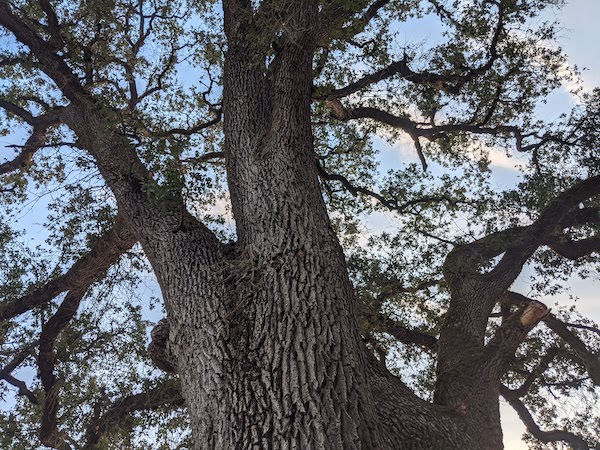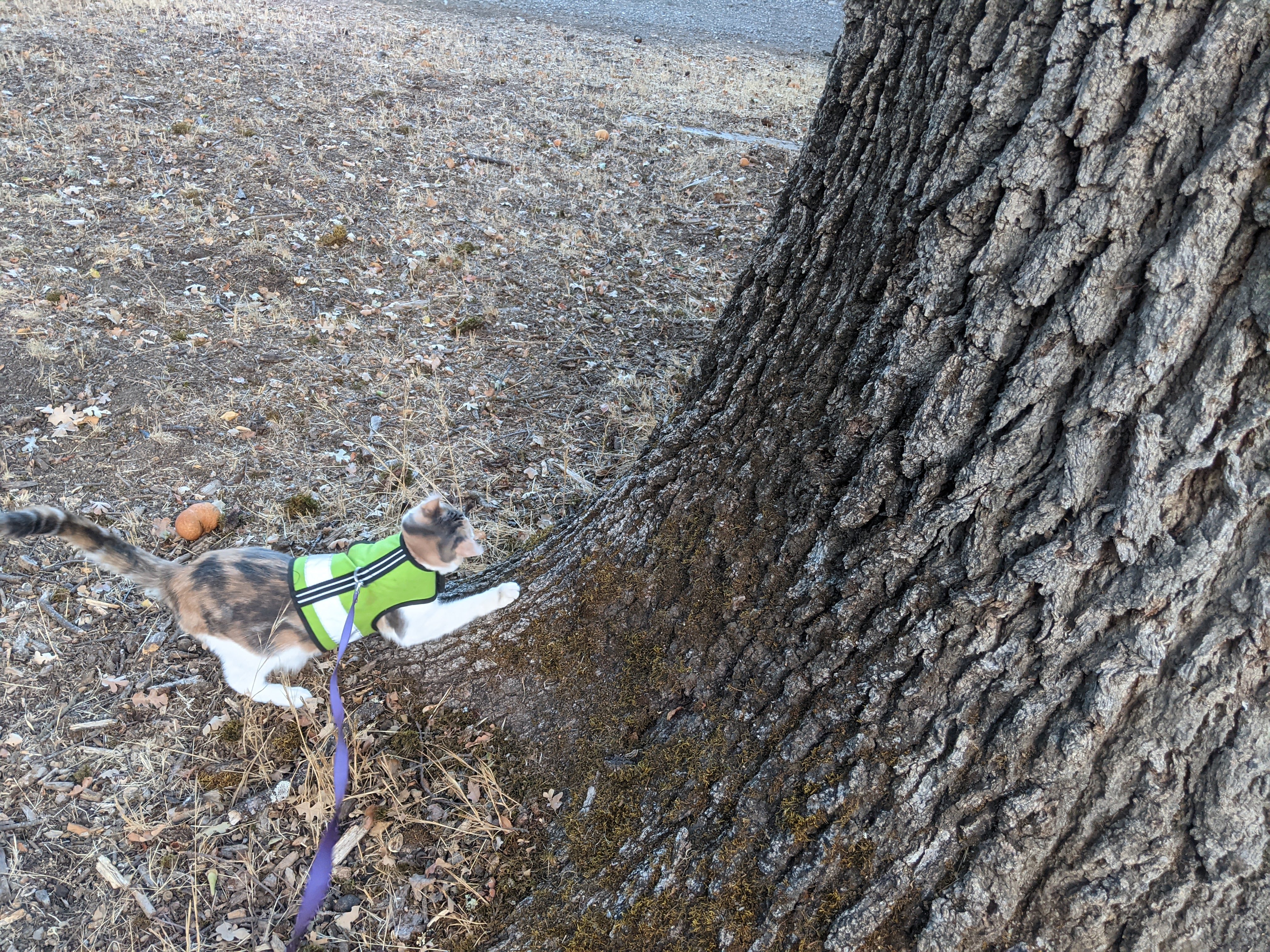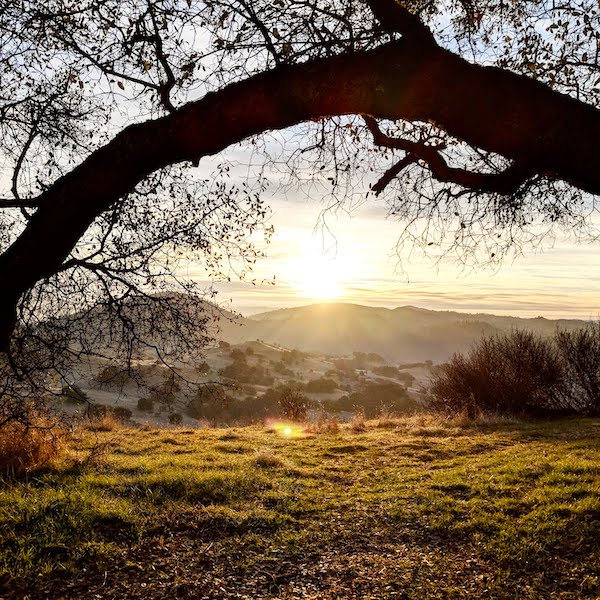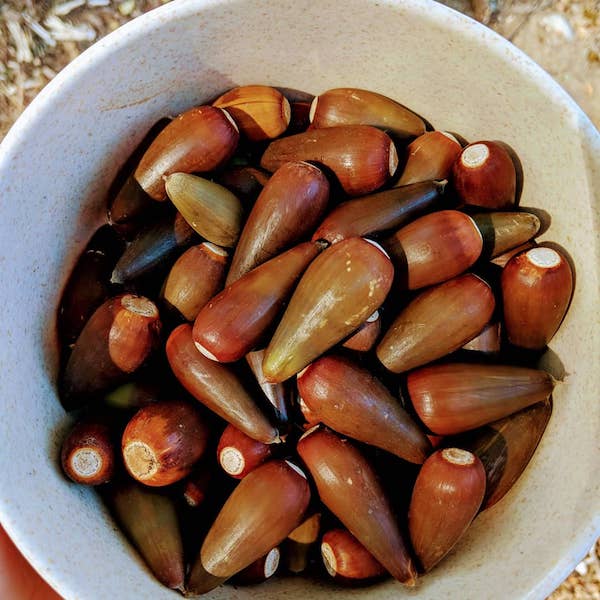
Our backyard oak.
All weekend I’ve been trying to write an article about oak trees for a rapidly approaching deadline, and not making much headway. I know what the problem is: Oaks aren’t a story, they’re too branched and sprawling, and I still need a path to follow through the woodland, or an acorn for distractable squirrel readers to nibble, or whatever. But I couldn’t find it, or maybe I just didn’t want to. Instead, I stared at a sprig of what I think is a blue or maybe a valley oak on my desk, and snuck outside to visit the trees in person.
Coffee in hand and cat on leash, I walked around the perimeter of our property, trying to better acquaint myself with the oak trees around my house. There are more oaks here than I’d realized: In addition to two massive trees that extend over our driveway, crowns touching, at least four saplings have sprung up nearby. The saplings are so dwarfed by their parents that I’d managed to ignore them. I walked down the road and noticed other oaks I’d overlooked, all different species: Some were small and shrubby, with spiny leaves, while others had lichen-spotted trunks and smooth leaves. I took pictures of all of them, hoping to identify them later, and let Calliope climb and sharpen her claws on their bark.

By noon on Sunday, I’d fallen under the spell of deep oak time, reading about a grey-green shrub called Palmer’s oak (Quercus palmeri). The oak has survived in southern California for 13,000 years—longer than our famous bristlecone pines and ancient redwoods. Oaks have been in California since long before the Pleistocene, I learned: In the La Brea tar pits of Los Angeles, along with the remains of wooly mammoths, camels, and giant ground sloths, scientists have pulled out 50,000 year-old oak leaves. They’re black and burnished from their time in the pits, but perfectly preserved.
Oaks have survived this long in the world’s driest Mediterranean climate because they’re amazingly resistant to drought, heat, and fire. With the help of various mycorrhizal fungi, their roots can break down granite boulders to reach deep water. But even the hardiest oaks have limits. In an oak tree, water travels up from the roots through tubelike cells called xylem, and out through stomata, tiny holes in leaves that open and close throughout the day. When it’s hot and dry, the atmosphere pulls harder on the water column inside the xylem. When it pulls too hard, and there’s not enough water to suck up from the ground, the column can snap like an overstretched rubber band. An air bubble called an embolism forms, and the xylem shuts down. Some oaks have more xylem than others, or their xylem are more vulnerable to embolisms; these and other adaptations will affect how different species fare as the climate changes.

When I was younger, I liked to imagine centuries-old oaks erupting out of the ground, dying, and being replaced by new, nubbly little green trees like broccoli florets, all in a few seconds. Today that process of renewal has been interrupted in many areas of California, through the loss of oak savanna to development, vineyards, and agriculture, pathogens like Phytophthora (Greek for “plant destroyer”) which causes sudden oak death, and drought and heat stress. Another, less-talked about factor is neglect: For at least 10,000 years prior to European arrival, Native Californians tended oaks with low-intensity fires that killed pests, encouraged acorn production, and prevented fir forests from encroaching, creating the parklike oak woodlands settlers found when they arrived. Gold Rush-era policies prohibited the practice, followed by a federal ban. Now, many experts agree that such burns are needed to restore oak woodlands and protect them from severe wildfires. This month, California lawmakers passed two bills that will make it easier for tribes to set prescribed burns on their lands.

“What kind of ancestor would you like to be?,” someone recently asked me. The question made me feel oddly empty, like an air bubble breaking the flow of water between soil and sky. A few days later my answer started to take shape: the kind you can bury your nose in, like moss that springs back after a first rain. The kind that casts billions of yellow-green pollen grains into the air each spring, betting that even in the worst times a few will form seeds. The kind that feeds over 500 species of caterpillar species, which in turn fatten hundreds of birds. That sends thousands of fat, glossy brown acorns pelting down into the yard from time to time, makes a racket on the tin shed roof, dents the car, and feeds the whole neighborhood with a seemingly reckless, mysterious abundance.
“Cat for scale” made me laugh out loud.
Also reminded of a picture in the “Nikon Small World” photo competition of the stomata and trichome of a live oak leaf. It’s really stunning. You should be able to find it here: https://www.nikonsmallworld.com/
I have always loved oaks since growing up in a part of the Chicago area that used to be farmlands. In fact I decided that when I die I want to be buried unembalmed at the base of an oak tree so I could become a part of it as my body decomposed. This sounds a lot like your description of what kind of ancestor you would like to be.
Lovely! And hope you made your deadline, too.